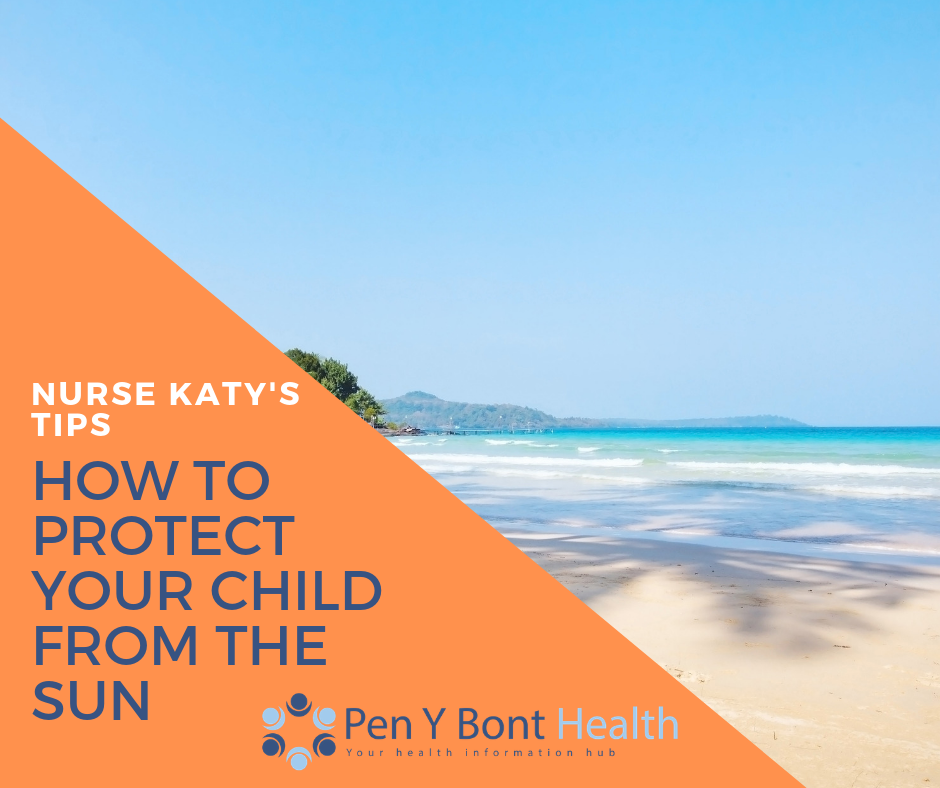We’re very proud of one of our Nurses; Nurse Katy from Oak Tree Surgery. Katy has been tirelessly campaigning to help protect the children of Bridgend from the sun after her own child got burnt whilst in school last summer. Katy is passionate about the introduction of a sun safety policy for all schools in Bridgend, and has been working with Bridgend Council and Tenovus to make this happen. Read Katy’s story here, and learn what you can do as a parent to protect your child from the sun. Please enjoy the sun, but enjoy it safely!
1. Tell us a bit about you and where you work
My name is Katy and I am a Practice Nurse at Oaktree Surgery, Bridgend. I am from Bridgend and I have two young children. I have been in the healthcare industry for 21 years this year.
2. Why did you get involved in the sun safety campaign?
My eldest daughter was sunburned whilst at school last summer, despite my having taken all necessary precautions at the time. I had applied cream in the morning, she had additional sun cream in her bag, and a hat and appropriate clothing, however, when I collected her from school, she had blistering burns to her neck, shoulders and arms from the sun. I discussed this with the school at the time and we discovered some issues, which I believed could be rectified with some interventions.
3. Why is it so important to you?
It is important to me because as a health care practitioner I believe that having preventative strategies in place, especially from an early age are beneficial to all individuals. It affected me personally; the lack of a mandatory policy in place to ensure the safety of my child in the sun whist under the care of her school had directly affected her, doubling her risk of developing skin cancer.
4. How have you got involved and what has the outcome been?
After discussing, originally, with the school staff and head teacher we agreed that there were improvements that could be made, including the introduction of a sun safety policy which had up to date information and continuity of recommendations across the board for implementing strategies to ensure the safety of all children during the sunny weather. I contacted Vaughan Gethin, who directed me to Kevin Griffiths, head of school improvement for the Welsh Assembly, and also to the health promotion team staff for healthy school improvements in Wales. We met at BCBC and discussed the policy templates I had gathered, as well as strategies to be put in place for improvements and to use in conjunction with the policy.
The outcome is that the policy is going to be introduced with immediate effect. Tenovus are also now involved and are working with schools that sign up to the free ‘Skcin’ programme, which includes free resources of ‘George The Sun Safe Superstar’, and I feel that a huge effort has been made in recognising the need and implementing the ideas brought forward to ultimately improve the safety of children in the sun whilst in school.
5. In your experience are parents and teachers vigilant enough in protecting their children from the sun?
In my experience, there is never enough vigilance in protection from the sun. The effects of sun damage can occur from the smallest of exposure times, if you are completely covered in factor 30 or above, re applied every 1-1.5 hours, and are completely covered, including a hat and are sat in the shade then you are relatively well protected.
Unfortunately, this is not feasible in most circumstances, no matter how vigilant you try to be. It is also more difficult for a teacher to be able to implement these strategies due to the staff/pupil ratio, awareness of allergies/skin conditions, children’s compliance with clothing/head wear, time constraints, whether the child/children has actually brought the correct protective equipment to school etc. All these issues can be addressed however and solutions explored as part of the sun safety campaign.
 6. What can parents do to be more vigilant?
6. What can parents do to be more vigilant?
Parents can read the information to be provided by schools, and/or attend the educational sessions to educate themselves on the sun safety strategies, and ultimately why they are being introduced. Dermatologists and skin cancer experts state that three episodes of sun burn or one episode of a ‘blistering’ burn can double the chance of that child later having skin cancer.
- Parents should ensure that their child is well covered with at least factor 30, preferably factor 50, which should be re applied frequently, especially after bathing.
- A hat should always be worn by the child, and clothing covering the body/skin.
- Where possible shade should be provided and the child, if possible should avoid being out in the sunlight when the UV rays are at their strongest, which is around 11am – 3pm.
- If the child is in school, a small sun screen should be put in their bag, labelled, (a roll on is a good choice for school time), and where necessary, liaise with the school if their child has any allergies or if any forms for allowing the application of sun screen needs to be completed.
- A hat should always be provided for school.
- Parents can discuss with schools where their areas of shade are, and ask if they have joined the sun safety campaign.
